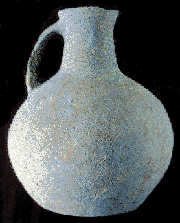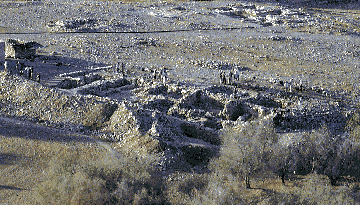|

More than 4000 years ago, the thriving Canaanite settlement of Khirbet Iskander carried on its daily existence along a caravan route called the “Kings
Highway,” east of the Dead Sea in Jordan. A special exhibit featuring
archaeological discoveries from this fortified Early Bronze-Age city has
been on display at the Erie Museum in Erie, Pennsylvania.
Fig.1: An earthenware pitcher from Khirbet Iskander (Erie Art
Museum, 2000).
The exhibition includes a variety of domestic and religious objects dated
to ca. 2350 BC. Foremost among these is a collection of remarkably preserved
ceramic vessels (fig.1), and other objects of daily life including food
processing tools of stone.
Khirbet Iskander which means “the ruin of Alexander" (the Great), has
no relationship to the Greek conqueror who lived around 323 BC. This much
earlier site flourished between 3500-2300 BC, the time when the first cities
appeared in the Near East. When other cities in the region had disappeared
by about 2300 BC, Khirbet Iskander survived for another 300 years, during
the period known as Early Bronze (EB) IV. 
Defensive systems at Khirbet Iskander were rebuilt between 2300-2000 BC,
and are, based on present information, the only EB IV fortifications known
from this time period in the southern Levant. A gateway and a public building
also date to this era.
Fig.2: View of the ancient town site at Khirbet Iskander (Erie
Art Museum, 2000).
.
This article appears in Vol.2, No.4 of Athena
Review.
.
|